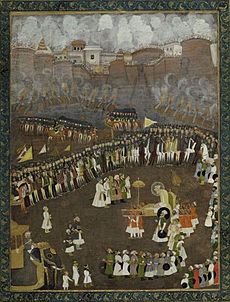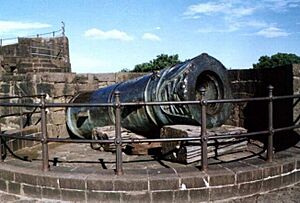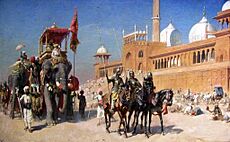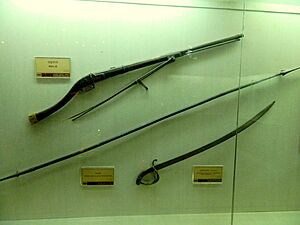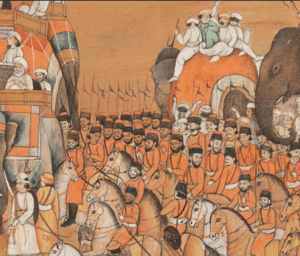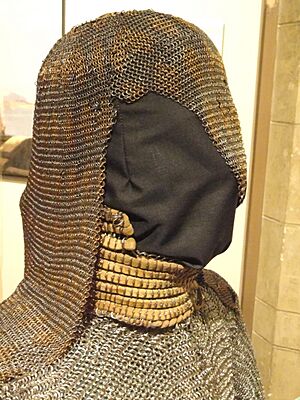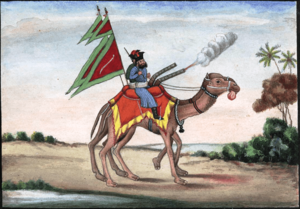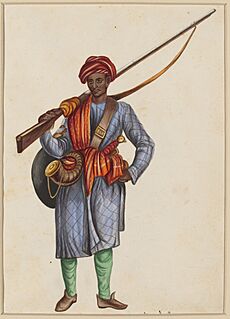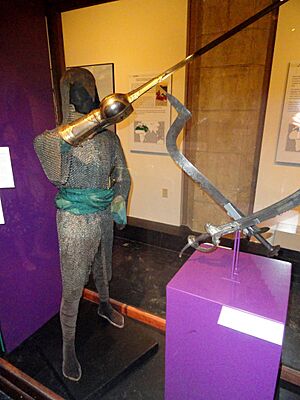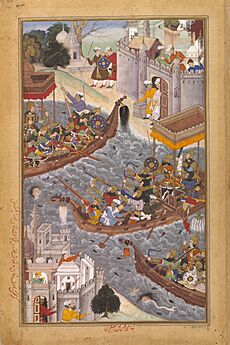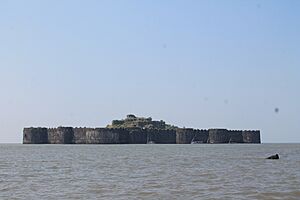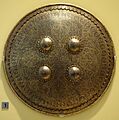Army of the Mughal Empire facts for kids
Quick facts for kids Mughal Armyارتش مغول |
|
|---|---|
| Alam of the Mughal Empire.svg Flag of the Mughal Empire |
|
| Established | c. 1556 |
| Disbanded | c. 1806 |
| Headquarters | Exalted camp / Victorious camp |
| Leadership | |
| Former Military | Timurid Army |
| Grand-Vizier | Mughal Vazere'azam |
| Serving soldiers | |
| Military age | 15-25 years |
| Available to be a soldier |
911,400-4,039,097 infantry 342,696 cavalry 4.4 million-26 million in total, age 15–49 |
| Expenditures | |
| Budget | 12,071,876,840 dams |
|
File:Farrukhsiyar Procession in front of the Great Mosque of Delhi.png |
|
The Army of the Mughal Empire was a powerful military force. It helped the Mughal emperors build their empire in the 1500s. This army also helped them expand it to its largest size by the early 1700s. The Mughals originally came from Central Asia. Their armies were mostly based on cavalry, which means soldiers on horseback. However, the third emperor, Akbar, gave the army its main shape and structure.
In the 1600s, the Mughal Empire had the biggest army in the world. It included between 911,400 and over 4 million foot soldiers. There were also about 342,696 cavalry soldiers. Some historians even believe the total number of people in the army could have been as high as 26 million.
The Mughal army was known as a strong military power in India. They used smart engineering for military tasks and were masters of logistics. This means they were very good at moving supplies and people. Historians have even compared their strength to the Roman Empire or the United States Armed Forces. The Mughal cavalry was especially strong in conflicts across India. Their heavy cavalry was known for its discipline and powerful charges.
The Mughal army also had a strong artillery. This included heavy cannons, lighter guns, grenades, and rockets. Heavy cannons were very expensive and hard to move. Elephants and oxen had to drag them into battles. The Mughal navy was called Amla-e-Nawara. In Dhaka alone, this navy had 768 ships. It also had 933 foreign crew members, many from Portugal.
Contents
History of the Mughal Army
The Mughal army was involved in many important conflicts. Here are some of them:
- Conquest of Babur (1504-1529)
- Battle of Khanwa (1527)
- Battle of Ghaghra (1529)
- Mughal–Rajput Wars (1526–1779)
- Battle of Haldighati (1576)
- Mughal–Afghan Wars (1526–1752)
- Mughal-Sur conflict (1535–1558)
- Second battle of Panipat (1558)
- Mughal-Sur conflict (1535–1558)
- Mughal conquest of Bengal (1572-1612)
- Mughal–Persian Wars (1605–1739)
- Mughal–Ahom Wars (1616–1682)
- Mughal–Sikh Wars (1621–1783)
- Mughal–Maratha Wars (1680–1707)
- Mughal–East India Company Wars (1686–1857)
- Indian Rebellion of 1857 (1857-1858)
The Mughals came from Central Asia. Their first emperor, Babur, had a small army that relied on horses. They used many horse archers. Babur's empire did not last long. The Mughal Empire that lasted longer was founded by Akbar in 1556. Even though the Mughals started as nomadic people, they settled down more over time.
The large Mughal army was known for its discipline. It also had many different ethnic groups among its soldiers. At its strongest, the Mughal Empire controlled almost all of northern and central South Asia. Enemies rarely dared to fight them head-on. Instead, they often used guerrilla warfare or avoided direct battles. By the time of Emperor Aurangzeb, most of the Mughal army was made up of native Indian Muslims.
Babur and Humayun's Military Campaigns

Babur started building his empire's military at the First Battle of Panipat in 1526. He used a clever tactic called Tulugma. This involved surrounding the enemy army and forcing them to face his artillery directly. This also scared their war elephants. His son, Humayun, faced many conflicts. One major enemy was Sher Shah Suri.
In 1535, Humayun learned that the Sultan of Gujarat was planning an attack with Portuguese help. Humayun gathered his army and marched. But instead of attacking, he secured the land he had already conquered. This gave Sher Shah Suri a chance to take control of Agra. Humayun then faced the Afghans led by Sher Shah. He won a battle in 1532 and then tried to capture Chunar. After four months, Sher Shah offered his loyalty, and Humayun accepted.
Later, Sher Shah attacked the Bengal Sultanate. Its ruler asked Humayun for help. Humayun marched to Bengal in 1537 and besieged Chunar again. It took over six months for the fort to fall. Sher Shah then took more land, including Bihar and Varanasi. Humayun marched into Bengal, but bad weather caused him to lose supplies. He eventually took Gauda without a fight.
However, Sher Shah had taken over much of Humayun's territory. In 1539, Sher Shah surprised Humayun's army at the Battle of Chausa. The Mughals were completely defeated, and Humayun barely escaped. He returned to Agra and gathered a large army of 40,000 soldiers. Sher Shah had 15,000. They met at Kannauj. The Mughal army was defeated again, and Humayun had to flee. Sher Shah then became Emperor of Northern India.
After Sher Shah's successor died in 1554, Humayun returned. He gathered a large army with help from the Safavid Empire. Many of his soldiers were Shi'a Muslims. Humayun put Bairam Khan in charge. Bairam Khan led the army through Punjab easily. They fought a major battle against Sikandar Shah Suri at Sirhind. Bairam Khan used a trick: he pretended to retreat, and when the enemy followed, they were surprised by hidden defenses. The Mughals won, and Humayun took back his throne in Delhi in 1555.
Akbar's Military Expansion
Akbar continued to expand the empire. He faced Hemu, a general who had declared himself Hindu emperor. Akbar's army, led by Bairam Khan, defeated Hemu at the Second Battle of Panipat in 1556. This was a very important victory. After this, Mughal forces took Delhi and Agra. Akbar then dealt with Sikandar Shah Suri, who had become active again. The Mughals won another big battle, and Sikandar fled. Akbar's forces then took Lahore and Multan.
In 1558, Akbar took Ajmer, opening the way to Rajputana. The Mughals also captured Gwalior Fort. Akbar had some disagreements with his regent, Bairam Khan, and eventually dismissed him.
In 1560, Akbar started more military actions. A Mughal army under Adham Khan began conquering Malwa. The ruler, Baz Bahadur, was defeated and fled. In 1564, Mughal forces began conquering Garha. This area was important because of its wild elephants. The Mughals gained huge wealth, including gold, silver, jewels, and 1,000 elephants.
In 1572, the Mughal Empire took over Gujarat. This gave them their first access to the sea. Akbar also had to deal with the Portuguese, who controlled trade in the Indian Ocean. The Portuguese recognized the Mughal army's strength and chose to make peace. In 1573, Akbar's forces put down a rebellion in Gujarat.
In 1576, the Mughal army, led by Man Singh I, fought the Rajput kingdom of Mewar at the Battle of Haldighati. The Mughal foot soldiers managed to defeat Mewar's war elephants.
From 1578 to 1597, the Mughal Empire fought a long conflict against a local Bengal warlord named Isa Khan. In 1584, Isa Khan and his ally defeated the Mughal general Shahbaz Khan Kamboh in naval and land battles. However, in 1597, Isa Khan finally submitted to Akbar after a long struggle.
In 1585, Emperor Akbar sent an army to deal with rebellious Afghan tribes. In 1586, the Mughals suffered heavy losses in the Battle of the Malandari Pass. An Afghan tribe confederacy killed many Mughal soldiers, including their commander, Birbal. Akbar sent another army to get revenge, killing many Afghans and selling survivors as slaves.
In 1591, Akbar faced another rebellion in Gujarat. The Mughal forces won the Battle of Bhuchar Mori and plundered Nawanangar. In 1594, Jahangir, Akbar's son, led an army to capture Orchha, a center of revolt. He won and ordered the building of the Jahangir Mahal to celebrate.
Jahangir and Shah Jahan's Military Actions

In 1608, Emperor Jahangir sent Islam Khan I to defeat Musa Khan, the rebellious son of Isa Khan in Bengal. Islam Khan succeeded and captured Musa Khan. This brought Sylhet under Mughal control for the first time.
In 1613, Jahangir took strong action against the Koli people in Gujarat, who were known as robbers. Many Koli chiefs were killed. In the same year, the Portuguese seized a Mughal ship carrying pilgrims and valuable goods. Jahangir was very angry. He ordered the capture of all Portuguese in the empire and took over their churches.
In 1615, after a tough war, Rana Amar Singh I surrendered to the Mughals. His kingdom became a vassal state. Jahangir rewarded his son, Khurram (who would later become Shah Jahan), for his success in this campaign.
In 1620, during the conquest of Kangra, Mughal forces broke idols and performed Islamic rituals. This showed a shift from Akbar's more open policies. Shah Jahan's son, Aurangzeb, also led military campaigns, including defeating the Bundela Rajputs in 1635.
In 1630, thousands of Pashtun tribes attacked the Mughal Army in Peshawar. In 1646, Ustad Ahmad Lahori led the Mughal army to Balkh to fight against the Safavid Iran.
Aurangzeb's Extensive Campaigns
In 1657, Maratha forces under Shivaji raided Mughal barracks. Aurangzeb sent his general, Nasiri Khan, who defeated Shivaji's forces. Aurangzeb then besieged Bidar. His forces used rockets and grenades to scale the walls. Bidar was captured after 27 days.
In 1659, Aurangzeb sent Raja Jai Singh to besiege the Purandar fort. Shivaji agreed to terms and visited Aurangzeb in Agra. However, Shivaji felt disrespected and escaped. He later crowned himself Chhatrapati (ruler) of the Maratha Kingdom in 1674. Aurangzeb's campaigns against the Marathas were interrupted by a civil war among his brothers for the Mughal throne.
In 1662, the Mughal Empire, led by Mir Jumla II, conquered the Ahom kingdom's capital, Garhgaon. They captured many elephants, coins, shields, and ships.
In 1667, the Yusufzai tribe rebelled again. Muhammad Amin Khan brought a 9,000-strong Mughal army. While the Mughals conquered the southern plains, they failed to take Swat from the Yusufzai.
In 1669, Hindu Jats rebelled under Gokula. By 1670, 20,000 Jat rebels were defeated, and Gokula was executed. Later, Raja Ram Jat plundered Akbar's tomb for revenge. Aurangzeb appointed Mohammad Bidar Bakht to crush the Jat rebellion. Raja Ram Jat was captured and beheaded in 1688.
Shivaji continued to defy the Mughals until his death in 1680. His son, Sambhaji, took over. Aurangzeb's son, Akbar, joined Muslim rebels in the Deccan. Aurangzeb moved his court to Aurangabad to lead the Deccan campaign. The rebels were defeated, and Akbar fled to Persia.
In 1683, the Maratha warlord Sambhaji attacked Goa, almost defeating the Portuguese. But Mughal forces arrived and saved the Portuguese.
In 1685, the Mughals besieged Bijapur Fort. It was well-defended by 30,000 men. The Mughals faced strong resistance and large cannons like the "Malik-i-Maidan". Maratha forces also cut off Mughal supplies. After 18 months, in 1686, the Mughals finally took Bijapur. Aurangzeb celebrated this victory.
In 1687, Aurangzeb also attacked Golconda. He besieged the Golconda Fort for 8 months. The Mughals won, and the Golconda Sultanate became a Mughal province called Hyderabad.
In 1689, Aurangzeb's forces captured and executed Sambhaji. Aurangzeb then pushed the Maratha forces south. However, the Marathas continued to fight individual battles. Territory changed hands many times between 1689 and 1707. Aurangzeb fought continuously in the Deccan for over two decades. He lost about a fifth of his army fighting the Marathas. He died at 88, still fighting them.
Aurangzeb also faced a Sikh rebellion in 1701. The Sikhs, led by Guru Gobind Singh, formed militant groups. The Mughal officials in Punjab were ordered to act against them. The Mughals subdued the Sikhs in the second battle of Anandpur in 1703-1704.
How the Mughal Army Was Organized
The Mughal emperors themselves kept only a small standing army. Most of the Mughal armed forces came from officers called Mansabdars. Under Akbar, there were about 1,600 Mansabdars. By Shah Jahan's time, this number grew to 8,000 officers. A Mansabdar was a government official responsible for recruiting and maintaining his own group of horsemen. Most of the Mughal army was under these Mansabdar officers. Their rank and pay depended on how many horsemen they provided.
Each Mansabdar reported to the Mir Bakshi, who was the head of the Mughal military and intelligence offices. Mansabdars were also often appointed as Subahdars, or heads of provincial administration. They were helped by other provincial officers.
The emperor also had his own personal army, numbering around 24,000 soldiers. These were called Ahadis, who were cavalry troopers. Another group of personal bodyguards was called Walashahis. These were the most trusted troops, paid directly by the Emperor. They were often men who had served the Emperor since he was a prince.
The Mughal army was generally divided into four main parts:
- Cavalry (Aswaran)
- Infantry (Paidgan)
- Artillery (Topkhana)
- Navy (Amla-e-Nawara)
These were not separate armies with their own commanders. Instead, Mansabdars would have some soldiers from each of these groups. The artillery was different because it was a specialized group with its own commander. The Mughals also had a harsh way of punishing rebels: they would tie them to the mouth of a cannon and blow them apart. The British army later copied this method.
Imperial Camp and Fortresses
The Mughal imperial camp was called "The exalted camp" or "The victorious camp". It was used for military trips and royal tours. It also served as a mobile capital and army headquarters. Hundreds of thousands of people lived in it. It needed 50,000 horses and oxen to carry all the tents, baggage, and equipment. One historian described it as "a moving city."
This mobile capital was built by over 2,000 workers who went ahead of the main party. From Akbar's time, Mughal military camps were huge. They included many people from the royal court, soldiers, and laborers. All government work was done within these camps. Mughal Emperors spent a lot of their time ruling from these camps. Akbar's large camps could hold 300,000 people. They rarely traveled more than 6 km per day. Agents and workers went ahead to prepare roads, bridges, and campsites.
Traveler Niccolao Manucci, who saw the camp, wrote that its grandeur was greater than any European ruler's. The Mughal army also used Persian traditions for their tents and pavilions. These structures were inspired by ancient Persian texts.
Besides these mobile camps, the Mughal Empire also built permanent military fortresses. Examples include Lalbagh Fort and Red Fort. They also inherited many forts, or qilas, throughout the Deccan region.
Mughal Army Manpower
Around the 1600s, the Mughal Empire was the richest empire in the world. It also had the largest military, with millions of regularly paid soldiers. Some historians believe the Mughal Empire's military power was unmatched by European powers at the time.
In 1647, the Mughal Empire could theoretically have 911,400 cavalry and infantry. Other estimates suggest the military could support about 342,696 cavalry and over 4 million infantry. Some historians even estimate the total number of military personnel, including support forces, could have reached 26 million. For example, Aurangzeb brought about 170,000 cavalry and a similar number of foot soldiers for a campaign in the Deccan alone.
The Mughal army was made up of many different ethnic groups. These included Persians, Turkmens, Uzbeks, Pashtuns, Gujaratis, Rajputs, and Balochis. These large numbers of foot soldiers were not just disorganized groups. They were units with different roles and equipment. Some were heavy infantry, like Roman legionnaires, while others were specialized sword fighters.
Arms and Weapons
The main places for making military equipment in the Mughal Empire were Delhi and Lahore. Karkhanas, or workshops, produced various weapons, ammunition, and horse equipment.
The main weapons used by the Mughals were swords, spears, and bows and arrows. The Firangi was a straight sword of European style. Many pictures show Mughal nobles holding these swords, which became a symbol of power. Rajput foot soldiers in Mughal service used halberds, maces, and even two-handed swords.
The Mughals widely adopted muskets and gunpowder weapons, especially during Akbar's time. When the Portuguese arrived in India in 1498, they brought firearms. Indian craftsmen quickly copied and adapted these weapons. These local muskets were called Toradar.
Mughal cavalry soldiers wore heavy chain mail armor. They also acted as cavalry archers, using composite bows. If they faced a difficult situation, Muslim Mughal cavalrymen would sometimes dismount and fight on foot until they died rather than retreat. Mughal armor was not as heavy as European armor because of the hot climate.
Cavalry: The Horsemen of the Empire
From Babur's time, horse archery was a key part of the Mughal army. By Emperor Jahangir's reign, the Mughal Empire had 342,696 cavalry troopers. The army's success depended heavily on its animals: war elephants, warhorses, and bulls for transporting artillery.
Historians believe that cavalry warfare became more important than elephant warfare. Rajputs, who traditionally fought on foot, were trained to be cavalry. Mughal officers had to maintain their own horses, elephants, and foot soldiers. Soldiers could be paid monthly or with land, called jagir.
Mughal Warhorses
The use of warhorses was central to Mughal power in India. They controlled the supply of excellent warhorses from Central Asia. About 75 percent of the Mughal army's warhorses were imported. Mughal victories, like the Second Battle of Panipat, often involved traditional Turko-Mongol horse archer tactics. Cavalrymen were usually from high social classes and were paid better than foot soldiers. They had to own at least two horses and good equipment. A regular horseman was called a Sowar.
Mughal cavalrymen were skilled at riding comfortably at top speed. They even mocked the "European style" of cavalry charge. The emperor directly recruited regular cavalry troopers, often from his own relatives and tribesmen. They were paid better than normal horsemen.
Riders were armed with bows, arrows, maces, lances, sabres, swords, and shields. Sometimes they also had rifles. Mughal cavalry armor was made of steel or leather, heavy chainmail, or plate armor. Their horses also wore protection. The armor covered the head, chest, and limbs. Underneath, they wore thick cotton or linen garments that could stop a sword or bullet. They also wore traditional tribal clothes.
The horses and musketeers recruited by Mansabdars had to meet high standards. Cavalry troopers rode strong breeds from Central Asia or Persia. These horses were generally larger than most horses found in India. The emperor used a special mark, Dagh, branded on the side of the horse to show its quality. Well-bred horses were imported from Arabia, Iran, or Central Asia. The emperor and high-ranking commanders used Arabian horses for their high quality.
The most valuable warhorse breeds for the Mughals were:
- Iraqi Arabian breed, considered the best.
- Arabian-Persian mixed breed, known for endurance, speed, and good temperament.
- Turkish breed, valued for strength, stamina, and long marches. This was the standard for regular Mughal cavalry.
The Mughals were known for their frontal-combat and shock-charge tactics using heavy cavalry with swords and lances. Mughal cavalry also trained to attack enemy war elephants by making their horses stand on their hind legs and jump forward. They also had skilled cavalry archers who could shoot arrows very quickly. One observer noted they could shoot 6 arrows before a rifleman could shoot twice.
War Elephants in the Mughal Army

The Mughal army also used war elephants. Commanders often led their troops from the top of an elephant. This gave them a high view to give orders. An elephant rider unit with two riders was called Howdah. Elephants were mainly used to carry heavy goods. The riders were called Mahouts. Female elephants usually carried baggage and siege cannons. Male elephants were trained for close combat against enemy foot soldiers.
A special elephant unit called Gajnal carried Indian swivel-guns on their backs. Two of these light artillery pieces could be carried by one elephant.
Mughal war elephants wore armor called Bargustawan-i-pil. This armor, made of Chain mail and Plate armour, weighed 118 kg. However, war elephants were vulnerable to firearms. The armor usually protected only the head and trunk. Elephants used by high-ranking figures might have full chainmail or steel plate armor. War elephants on the front lines were used as shock troops. Their charge was hard to stop, except by very disciplined foot soldiers.
In 1581, a Jesuit recorded that Akbar used about 500 elephants and 28 cannons in a battle. During Aurangzeb's rule, a commander bought 30 to 50 war elephants from Ceylon. Akbar and Jahangir used elephants a lot in warfare. Akbar kept between 5,000 and 7,000 elephants. The Mughals were more interested in war elephants than earlier Indian rulers. Akbar was a strong supporter of using elephants in battle.
Elephants were also important symbols of power in South Asia. The Mughals adopted elephant training into their dynasty. One writer stated that a good elephant was worth 500 horses in Mughal society.
Camel Cavalry: The Zamburaks
Some Rajput Mansabdars also provided camel cavalry. The Zamburaks, or camel units with mounted swivel guns, were seen as a Mughal invention. They were very mobile compared to elephant units. These weapons, twice the size of normal muskets, could be fired from the camels' backs.
Emperor Akbar reportedly used camel trainers from Baloch and Rabari ethnic groups. His own camel corps had about 6,000-7,000 camel riders.
Infantry: Foot Soldiers of the Empire
Foot soldiers were recruited by Mansabdars or by the emperor himself. The emperor's own infantry was called Ahsam. They were usually not well-paid or equipped, and lacked discipline. This group included gun bearers, swordsmen, servants, and artisans. They used many different weapons like swords, shields, lances, clubs, pistols, rifles, and muskets. They usually wore no armor.
Unlike Europeans who placed wagon forts at the back, the Mughals put their wagons at the front of their army. Chains connected the wagons to stop enemy cavalry charges. These wagon forts provided cover for slow-loading Indian rifles. They also protected the heavy cavalry positioned behind the infantry.
Musketeers: The Banduqchis
The rifle infantry units were generally more effective than archer units. The Banduqchis were the musket infantry. They made up most of the Mughal foot soldiers.
Mughal musket infantry could break an enemy's elephant charge without cavalry help. This was seen in the Battle of Haldighati. They were also very useful in rural areas to put down local rebellions.
These foot soldiers were recruited locally and used matchlocks, bows, and spears. They were considered low status. Their matchlocks were slower than mounted archers. Indian Muslims usually joined the cavalry and rarely the infantry, as they looked down on fighting with muskets. The Banduqchis were mainly Hindus from various castes known for their shooting skills.
Heavy Infantry: The Shamsherbaz
The main infantry was supported by specialized units called Shamsherbaz. This name means "sword-wielders" or "gladiators." They were elite heavy infantry companies of very skilled swordsmen. Some were palace guards or performed in mock battles. However, tens of thousands were assigned to army units by the Mansabdars. Shamsherbaz were often used in sieges. They would deal with resistance once walls were breached by explosives or artillery.
There were different types of Shamsherbaz units:
- Yak-hath: Soldiers with a single-handed weapon and a shield.
- Banaits: Soldiers armed with a curved longsword called Bankulis.
Many Shamsherbaz were recruited from religious groups or Rajput tribesmen. One chronicler recorded about 1,000 gladiators in the Mughal royal palace alone. The empire employed about 100,000 gladiator infantry in total.
Archers: The Dakhili Troops
Infantry archers in the Mughal Empire were called dākhilī troops. The emperor assigned them under Mansabdar officers. A captain of 10 archers was called Mīr-dah. In Akbar's later years, there were about 3 archers for every 1 musketeer in the Mughal army. Archer units had a similar role to musketeer units.
Slave Soldiers: The Chela
Chela were slave soldiers in the Mughal army. Commanders used them as a core force because they were very loyal. They had no one else to rely on but their master. These troops were fed, clothed, and housed by their employer. Many were raised and trained by their masters. They were mainly recruited from children taken in war or bought during famines. Most were Hindu originally but converted to Islam when they joined the Chela unit. These slave units were the only troops a commander could fully trust.
Unlike other Islamic states, the Mughal Empire did not use slave soldiers as their regular army. Chela soldiers mainly worked as laborers, footmen, and low-level officers. However, eunuch officers were valued for their loyalty.
Female Palace Guards: The Urdubegis
During the Mughal Dynasty, urdubegis were women assigned to protect the emperor and the people living in the zenana, or the emperor's Harem. Since the women of the Mughal court lived separately, the Harem was run entirely by women. Emperor Akbar organized his zenana, which had over 5,000 noble women and servants.
The women who protected the zenana were often from Habshi, Tatar, Turk, and Kashmiri backgrounds. Kashmiri women were chosen because they did not follow the practice of purdah (seclusion). Many of these women were bought as slaves and trained for their roles.
They are mentioned as early as the reigns of Babur and Humayun. They were skilled in using weapons, especially lances and bows. Mughal emperors spent a lot of their free time in the zenana and slept there. So, the women protecting the women's quarters were also part of the larger system to protect the emperor. During Babur and Humayun's time, the harem moved with the Emperor. This made it necessary to have trustworthy female guards. These Urdubegis also guarded the harem during trips and sieges. Some of these warriors rose through the ranks or were promoted by the Emperor.
Artillery: The Big Guns
Mughal artillery included different types of cannons, light artillery, and grenadier units. The artillery was a special group with its own commander, the Mir-i-Atish. This commander became very important in later Mughal times. They were in charge of defending the Imperial Palace Fort and had direct contact with the Emperor. Cannons were sometimes risky to use because they could explode, killing the crew. Light artillery was most useful in battle. These were usually made of bronze and pulled by horses. This also included swivel guns carried by camels, called zamburak.
One of the largest cannons used by the Mughal army was during the Siege of Chittorgarh (1567–1568). It was a huge mortar designed by a Persian engineer. This mortar could fire a cannonball weighing over 3,000 pounds. Another mortar was used in 1659 during a conflict between Aurangzeb and his brother.
The Mughals also used rockets as weapons. Emperor Akbar reportedly used metal cylinder rockets called bans against enemy war elephants. In 1657, the Mughal army used rockets during the Siege of Bidar. Aurangzeb's forces used rockets and grenades while climbing walls.
The Mughal artillery also used hand grenades and rocket artillery. These rockets are seen as early versions of the Mysorean rockets used later by Hyder Ali and Tipu Sultan.
The Mughals also had a significant naval force called Amla-e-Nawara. In Dhaka alone, this fleet had 768 ships with 933 foreign crew members, many of Portuguese origin. It also had 8,112 artillery personnel in the eastern part. The navy's main job was to control piracy and sometimes fight in wars. To support naval operations, the Mughal grand vizier Mir Jumla II repaired and strengthened three river forts between 1660 and 1663.
Bengali shipbuilders were very skilled. The British East India Company even copied their shipbuilding techniques in the 1760s. This led to big improvements in European ships.
Mughal Ships
Mughal warships in Bengal were often Ghurab warships. These ships had 14 guns and 50 to 60 crew members. Their officers were recruited from Dutch, Portuguese, British, and Russian naval officers.
Mughal warships were known for their strength and size. This was thanks to the skill of Bengali shipbuilders. While the Bengal navy used riverine Ghurab warships, the navy of Janjira state, supported by Aurangzeb, built larger ships like frigates and Man-of-wars. Some Mughal Man-of-war ships were as big as English Third-rate ships. Some of these ships carried 30 to 40 cannons.
The Mughals also operated very large imperial ships. The Rahīmī was 1,500 tons. Another huge ship was the Ganj-i-Sawai, which had 800 guns and weighed 1,600 tons. It was reported to be the largest ship in Surat at that time.
For two decades in the late 1500s, the Mughal Empire faced challenges in Bengal due to the rainy climate and many rivers. Their opponents were local warlords with many warships. These locals were also helped by Portuguese and Dutch pirates. However, some Portuguese also helped the Mughals.
The Mughals also operated in muddy areas. They built simple river forts using local Bengali techniques. Their naval strategy focused on mobile ships protected by these river forts. They also built floating river forts by tying ships and large rafts together. Heavy artillery was brought on board rafts, and wagons were tied to decks to create temporary defenses.
Emperor Akbar established the Mughal saltwater navy in the late 1500s after conquering Bengal and Gujarat. He reorganized the navy from civilian vessels into a more professional system. The navy's main goals were to maintain transport and combat ships, keep skilled sailors, protect trade, and collect taxes. Akbar was said to have 3,000 armed vessels, though this number later decreased to 768. In the early 1600s, the Mughals used Bengali local warriors as their naval force. These local warlords were responsible for shipbuilding, trade, and military protection.
About 20 years after the Siege of Hooghly, the Mughals in Bengal fought against the English East India Company. The English were defeated by the Mughal counterattack. In 1572, Akbar tried to get small cannons from the Portuguese but failed. This was why the Mughals could not build a strong navy along the Gujarat coast.
Empress Mariam-uz-Zamani owned large trade fleets, including the Rahīmī and Ganj-i-Sawai. The Rahimi was the largest Indian ship trading in the Red Sea. After pirates attacked it, it was replaced by the Ganj-i-Sawa. This ship was later attacked by the English pirate Henry Every.
One of the best-documented naval campaigns was against the kingdom of Arakan. In 1665, Aurangzeb sent Shaista Khan, his governor of Bengal, to command 288 vessels and over 20,000 men. Their goal was to stop pirate activities and capture Chittagong. They were also helped by about 40 Portuguese vessels. The Mughals and Portuguese won the naval battle. Chittagong was renamed Islamabad and became a Mughal headquarters. This battle involved over 500 ships and more than 40,000 people.
It is said that the British navy commander, Sir John Child, made peace with the Mughal Empire in 1689. This was because he feared the "Mughal navy" of Janjira, led by Siddi Yaqub. The Janjira and Mughal naval forces often clashed with the Maratha Navy and usually won. In 1672, Aurangzeb sent 30 small frigates to help the Siddis. This battle caused Shivaji's naval forces to lose 50 ships.
During Aurangzeb's time, the Mughal Empire struggled to build a strong navy. They failed to stop losses of Muslim ships near the Maldives. Aurangzeb was said to have four huge ships at Surat. His Vizier, Jafar Khan, blamed the lack of an effective navy on a shortage of skilled men, not money. Some historians believe the Mughal navy did not become a high-seas fleet because Indian furnaces were not as advanced as European ones for making cannons.
However, Aurangzeb did strengthen the fort of Janjira island. He also worked with the semi-independent Siddi community's naval force of Janjira State, which resisted the Marathas. The Siddi Yaqub navy showed its skill during the Siege of Bombay. They blockaded the fortress and forced the British to surrender. Siddi Yaqut received money from Aurangzeb to manage Murud-Janjira. He also owned large ships that could transport soldiers for amphibious operations. Mughal generals like Mir Jumla II used British, Dutch, and Portuguese sailors and their ships.
See also
- Tipu Sultan
- Sir John Child
- Yahya Saleh
Images for kids
-
Man Singh I a Predominant Mansabdar



